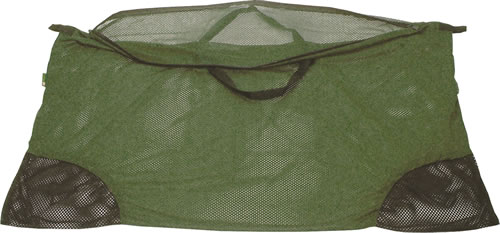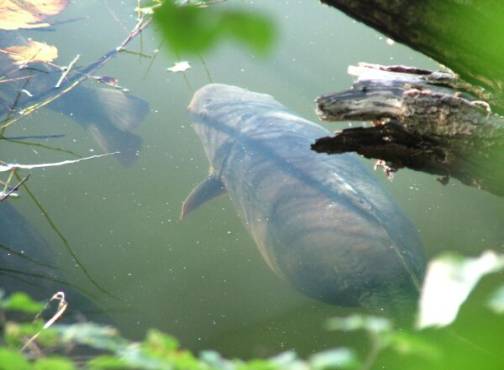|
Fish
Care - Sacking Carp, if you must - By
Carpfishing UK |
While
the debate as to whether or not we should sack carp goes on, some people
will feel that they need to sack their carp to get that perfect snap,
and why not? If you feel that you must use one then use it with both
great thought and great care. If you don't know how to use a carp sack
or don't feel confident in using one, then don't until you know what
you're doing. In order to do so, read on and hopefully this article will
tell you all you need to know.
We'll start this guide by saying that here at
Carpfishing UK we generally do not recommend the use of carp sacks or at
least not for anyone that isn't fully confident is doing so, however
they are on sale in every tackle shop so we feel that a guide of this
type is not only needed but is essential reading for those who intend to
use a carp sack for the first time.....If you must use a carp sack then
try not to do so for a minute longer than is necessary..!!
Most modern cameras will take good quality pics in low light and night
time so taking your pic and then immediate release is in our opinion the
way to go, carp can safely be retained in the landing net while your
camera/weigh equipment is being sorted by simply having a friend or
fellow angler hold the net containing the fish for you, or if you are
alone the net can slipped over a pre-placed bankstick by the waters edge
which will stop the net being pulled into the water by an angry
carp.....but if the water is too shallow to retain a
fish in your net or you still prefer to use a sack then read on
and keep all the safety points mentioned in mind while doing so.

The
Trakker conservation zip sack, a good quality sack with strong anchor
points good airflow, secure zip and soft mesh.
The most common reasons for sacking carp are;
*holding the fish whilst preparing the camera, weigh sling and so on.
*waiting for the morning light to enable the best possible pic of your
latest whacker.
First of all, always make sure the fishery rules allow the use of carp
sacks. If sacks are not allowed then seek help with your photographs or
practice self-take photography before hand and maybe practice at home
before fishing. See
Self Take Photography
- By Steve Noctor for help
with this.
When sacking a Carp it must be sacked in a specifically designed sack
for the job. You require one that features good water flow, strong
seams, locking zips or a locking draw string, and a long tough cord.
If there is any doubt regarding oxygen levels in the water the use a of
a carp sack is unacceptable. At night avoid areas that has dense weed
growth because the weed will emit carbon dioxide at this time. Sheltered
shallow areas in warm conditions can also be lacking enough dissolved
oxygen and need to be avoided too.
We strongly recommend that you permanently attach some kind of brightly
coloured pike bung or similar on an over depth cord to your carp sack.
Should the worst happen and the sack's cord come away from it's fixings
(which of course should never happen) the pike bung will come to the
surface hopefully allowing you to locate the sack. There can be no worse
way for such a great creature to die than in a lost sack. Make sure this
never happens..!!
The sack must be placed in the deepest snag free margin available and
must be secured by the cord to a solid object. A well planted bank stick
or perhaps a tree or post of some sort is desirable. Whatever happens
the sack must not be allowed to break free with an imprisoned carp
inside. The cord must be tied with a strong knot that isn't going to
come undone. Keep an eye out for rats as they have been known to chew
though sack cords that smell of fish slime.
You must also consider the weather conditons. If you are fishing into a
strong wind the resulting waves can batter a sacked fish against the
bank side or push it into very shallow water. If necessary stake the
fish further out into the lake to a well secured storm rod. Bear in mind
that the Carp must be positioned somewhere you can see it and must be
checked at regular intervals to insure the carp is fine. Therefore, if
you sack a fish at night we strongly recommend that you should stay
awake in order to carry out those regular checks. Make sure that the
fish looks comfortable and is upright and shows no sign of distress.
Should the fish at any time appear to be struggling then it should be
removed from the sack and held in the water in the release position. Let
it fully recover and swim away without the desired photograph. You can
always catch it again so long as its alive.
When you come to lift the fish from the water it will be full of energy
so be careful. Make sure before lifting that all of the Carp's fins are
tucked up against its body (except it's tail of course). You do not want
to damage its fins by bending them in the wrong direction. Always try to
suport the fish with one hand too as this will lessen the pressure on
the seams and stitching of your sack.
Please, always make sure you treat the whackers that give us
so much pleasure and keep us off the streets, with great respect. Try to keep the time you retain a
carp to the minimum. Always show them the greatest of care when they are
out of their natural environment, whether in your net, on your mat or in
your carp sack. Please ensure that they are always returned safely and
undamaged for others to enjoy in the future.
Be lucky & tight lines from all at Carpfishing UK.

|

